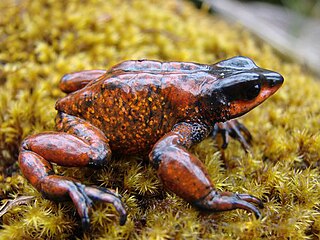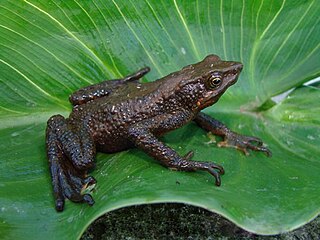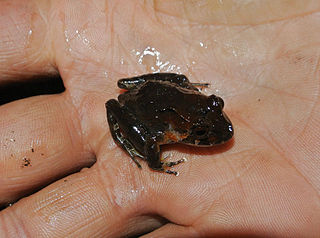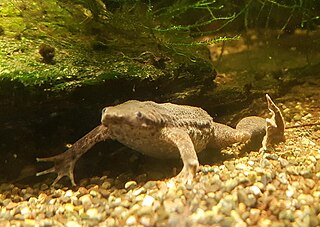
Cryptobatrachus is a genus of frogs in the family Hemiphractidae. They are found in Colombia and Venezuela. They are also known as backpack frogs, as the females have the habit of carrying their egg clutch on their backs until the young hatch; this behavior also occurs in the related hemiphractid genera Hemiphractus and Stefania.

The Guajira stubfoot toad or Carrikeri harlequin frog is a species of toad in the family Bufonidae. It is about 5 cm (2.0 in) long and typically black, though some populations have orange coloration. This species is endemic to the Sierra Nevada de Santa Marta mountain range of northern Colombia. It is critically endangered because of the chytrid fungus, Batrachochytrium dendrobatidis, and habitat destruction due to agriculture. The species had not been seen from 1994 until it was rediscovered in early 2008.

Atelopus laetissimus is a species of toad in the family Bufonidae. It is endemic to Colombia and only known from the area of its type locality in the northwestern part of the Sierra Nevada de Santa Marta, in the Magdalena Department.

Atelopus nahumae is a species of toad in the family Bufonidae. It is endemic to Colombia and only known from humid montane forest of Sierra Nevada de Santa Marta in the Magdalena, La Guajira, and Cesar Departments.

Ikakogi tayrona, or the Magdalena giant glass frog, is a species of frog in the family Centrolenidae. It is endemic to the Sierra Nevada de Santa Marta, Magdalena Department, Colombia. It is the only glass frog that is known to show maternal care.

"Colostethus" ruthveni is a species of frog in the family Dendrobatidae. It is endemic to the Magdalena Department in northern Colombia. The specific name ruthveni honors Alexander Grant Ruthven, an American herpetologist. It is known from the lower slopes of the north-western portion of the Sierra Nevada de Santa Marta. Its natural habitats are tropical dry forests and cloud forests where it occurs near streams, and is threatened by habitat loss. Males of this species on average have a snout-vent length of 18.9–20.1 millimetres (0.74–0.79 in) whereas females average about 19.8–24.1 millimetres (0.78–0.95 in).

Scinax boulengeri is a species of frog in the family Hylidae. It is found in Colombia, Costa Rica, Nicaragua, Panama, and possibly Honduras. Its natural habitats are subtropical or tropical moist lowland forests, intermittent freshwater marshes, pastureland, plantations, rural gardens, and urban areas. It has been found as high as 600 meters above sea level.
Cryptobatrachus fuhrmanni is a species of frog in the family Hemiphractidae. It is endemic to Colombia and occurs on all three Andean cordilleras: it is found on the eastern slope of the Cordillera Occidental, northern and eastern flanks of the Cordillera Central, and the western slope of the Cordillera Oriental. The specific name fuhrmanni honors Otto Fuhrmann, Swiss zoologist and helminthologist.
"Hyla" nicefori also known as the Colombian backpack frog, is a species of frog in the family Hylidae. It is endemic to the border region between Boyacá and Casanare in Colombia and only known from the holotype. The name format, as used by the American Museum of Natural History's Amphibian Species of the World, indicates that while this species is temporarily kept in the hylid type genus Hyla, it belongs elsewhere in the family and will be reassigned pending a taxonomic resolution. It was originally placed in Cryptobatrachus, but a later study revealed a number morphological differences showing that it is not in family Hemiphractidae, instead pointing to it being a hylid frog, perhaps Hyloscirtus.
Serranobatrachus delicatus is a species of frog in the family Strabomantidae. It is endemic to the Sierra Nevada de Santa Marta, Colombia, and is only known from the Magdalena Department. Common name delicate robber frog has been coined for this species.
Serranobatrachus ruthveni is a species of frog in the family Craugastoridae. It is endemic to the north-western slope of the Sierra Nevada de Santa Marta in the Magdalena Department, northern Colombia. The specific name ruthveni honors Alexander Grant Ruthven, an American herpetologist. Common name Ruthven's robber frog has been coined for this species.

Tachiramantis tayrona is a species of frog in the family Strabomantidae. It is endemic to the north-western Sierra Nevada de Santa Marta, Colombia. The specific name tayrona refers to the pre-Columbian Tairona culture. Lynch and Ruíz-Carranza suggest that this species might have been a model for the gold frogs unearthed from archaeological sites in the area.

Fritziana goeldii, also known as Goeldi's frog or Colonia Alpina treefrog, is a species of frog in the family Hemiphractidae. It is endemic to southeastern Brazil and found in Rio de Janeiro, Espírito Santo, and São Paulo states. The species is named after Émil Goeldi, Swiss zoologist who worked in Brazil. Fritziana goeldii may be locally threatened by habitat destruction but over most of its range it is a common species with a large total population, and the International Union for Conservation of Nature has rated its conservation status as being of "least concern".
Gastrotheca andaquiensis, commonly known as the Andes marsupial frog, is a species of frog in the family Hemiphractidae. It is found on the Amazonian slopes of Andes in southern Colombia and Ecuador.

The horned marsupial frog, originally named Nototrema cornutum (Boulenger) after the first describer George Albert Boulenger in 1898), is a species of frog in the family Hemiphractidae. It is an arboreal species found in Colombia, Costa Rica, Ecuador and Panama. Its natural habitats are tropical moist lowland forests and montane cloud forests. It is threatened by habitat loss.

Gastrotheca dunni is a species of frog in the family Hemiphractidae. It is endemic to the northern part of the Cordillera Occidental in northern Antioquia, Colombia. The specific name dunni honors Emmett Reid Dunn, an American herpetologist. Common name Dunn's marsupial frog has been coined for it.

Geobatrachus walkeri, commonly known as Walker's Sierra frog, is a species of frog in the family Craugastoridae. It is the only species in the monotypic genus Geobatrachus. It is endemic to Sierra Nevada de Santa Marta, Colombia. Its natural habitat is subtropical or tropical moist montane forests. It is threatened by habitat loss.

Pipa parva, is a species of frog in the family Pipidae. It is found in northwestern Venezuela and northeastern Colombia, mainly in the Maracaibo Basin. There is an introduced population in the Lake Valencia Basin in northern Venezuela.

The Santa Marta montane forests (NT0159) is an ecoregion in the Sierra Nevada de Santa Marta, a massif on the Caribbean coast of northern Colombia. The ecoregion covers altitudes from near sea level up to around 3,300 metres (10,827 ft), where it gives way to Santa Marta páramo. The isolation of the massif and the range of elevations and climates has resulted in a wide variety of species including many endemics. The lower levels contained tropical rainforest, which has largely been cleared. Higher up, this gives way to cloud forest. Much of this has also been cleared for coffee plantations, pasture for sheep and cattle, and farming.
Cryptobatrachus ruthveni is a species of frogs in the family Hemiphractidae. It is endemic to the western flank of the Sierra Nevada de Santa Marta in northern Colombia. The specific name ruthveni honors Alexander Grant Ruthven, an American herpetologist who was the first one to study.















